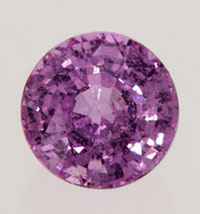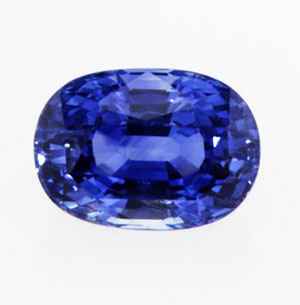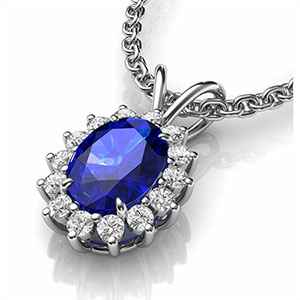Sapphires- The Stone with a Rainbow of Color Choices

Natural Sapphire colors
Sapphire, the birthstone of September is a gemstone that is loved by many. Occurring in an array of sparkling colors, sapphire is the gem for 5th wedding anniversary, as well as for the 45th year. With refracting index between 1.762 and 1.770, sapphires are a member of the corundum mineral family. When it comes to sapphires, blue sapphires come first. Blue sapphires occur in a variety of colors ranging from pure blue to greenish blue to purplish blue. The corundum mineral also produces an assortment of crystals in colors green, orange, yellow, purple, pink and other analogous colors. These stones are called fancy sapphires because of their decorative colors.
While most sapphires have monotones, there are some that undergo color change. Under bright daylight and fluorescent lighting, these gems change from blue to purple. Other than the said colors, sapphires also occur in black, brown and gray colors.

1 carat natural Pink Sapphire
Let’s read more on these spectacular stones.
The Star Sapphires of the World
In blue sapphires, the gems that come from Kashmir are the standard. Their velvety deeply saturated color makes them remarkably gorgeous. The engagement ring that can be safely called the worlds most famous is Kate Middleton’s blue sapphire royal ring. The ring wears a spectacular oval-cut blue sapphire on a floating setting encircled by a ring of diamonds. The ring is breathtaking in its design and effect. Blue sapphires may be the stars everywhere, but pink sapphires are not far behind. Padparadscha is the name of a rare kind of pinkish-orange sapphire, its name in Sinhalese means lotus blossom.

Kate Middleton Natural Sapphire engagement ring
Fancy Sapphires
Blue sapphires have a higher availability than the fancy colored ones. Fancy colored sapphires are scarce, particularly in sizes too small and too large. Although in short supply, these sapphires have a fair bit of demand in the market, especially among buyers who believe in the stone’s romantic association. The fancy colored stones give the buyers a rainbow of choices that are quite rare, in other varieties of gems. Blue sapphires get their color from the trace elements titanium and iron whereas pink sapphires are given color by an element called chromium. Fancy sapphires hadn’t shot to popularity until 1890s when a vast deposit of these motley gems was discovered in Madagascar and East Africa. That event brought the stones right under the spotlight. Soon, Sri Lanka stepped in to offer its own natural produce of yellow, pink, purple and orange sapphires.

Diamonds-USA natural Royal Blue 2.68 carat
Colorless Sapphires
There was a time when sapphires substituted for diamonds in gem jewelries. The colorless sapphires can easily pass for diamonds because of their aesthetic resemblance. Colorless sapphires are formed when corundum in its purest form crystalize. These sapphires, once popular around the world as inexpensive diamonds are once again making a comeback. This time around, they are introduced as accent stones. But, like fancy colored sapphires, colorless sapphires too are rare and that makes diamonds an easy option at hand.
What Makes a Sapphire a Valuable Stone?
There are more than one reason that makes sapphire a valuable stone. First is its vivid and intensely saturated color. Blue sapphires often bear a vivid blue color which makes it appear illuminated from within. If you have studied this gem closely, you would already be familiar with the term sapphire silk. Sapphire silk refers to thin intersecting needles made of rutile that dissect the insides of the crystal. These silky veins are delicate and add to intensify the color of the gem. Lastly, sapphire is a highly durable gem. Although not as much as diamonds, but hard enough to qualify as building materials for space crafts and supermarket scanner windows.
The 4Cs of a Sapphire
As mentioned above sapphires are not always blue or yellow. They come in a range of delightful colors some of which come under the fancy sapphires range. However, the most valuable ones are those that have vivid colors and high saturation.
Clarity of a sapphire cannot be compared to diamonds. Even the colorless sapphires carry inclusions visible to naked eyes. Although sapphire silk is a common phenomenon in most stones and that include the most expensive ones, they have much better clarity than another member of corundum family, rubies.
Sapphires are available in great many cuts. They are often given brilliant cuts of multiple kinds for best effect. Sapphires are normally cut with brilliant crown patterns and step cuts along the pavilion. You can get a sapphire cut in round, emerald, oval and a range of other popular cuts.
Large stones in blue sapphires is not uncommon. In fact, large blue sapphires are I greater supply than rubies of similar size. The price of sapphires, no matter the color, goes up with the carat size. Large blue sapphires are often used to decorate pendants, tiaras and even bracelets.

Emerald shape natural Pink Sapphire 1 carat
Buying Tips
Buying a sapphire requires a bit of preparation. To reap the best results from your investment, try and understand the color differences of sapphires with an expert. Place sapphires side by side to make comparison. If you are looking for affordable options in sapphires, pick from midnight and navy blue shades or straw yellow or grayish blue colors. They are less vivid and thereby, more affordable than others.
When it comes to the cut, you don’t want to make compromises to tailor it to your budget. The cut quality controls the brilliance and beauty of the stone. Your sapphire will sparkle at its best when it is fashioned with a high-grade cut.
The last thing to look out for is the kind of treatment the stone has been given. Sapphires, both blue and those that come in fancy colors are often color treated. For that, heat or lattice diffusion is used to intensify the tone and saturation of the stone. Those treated with lattice diffusion are often less valuable than those treated with heat. When buying sapphires, get a copy of the lab report to know exactly what you are investing in. Great majority of the Sapphires in the world are heat treated, it is common practice. The non-heated are extremely expensive.

Sapphire pendant, Sapphire necklace
****
![Black Friday Sale]()




 ​
​